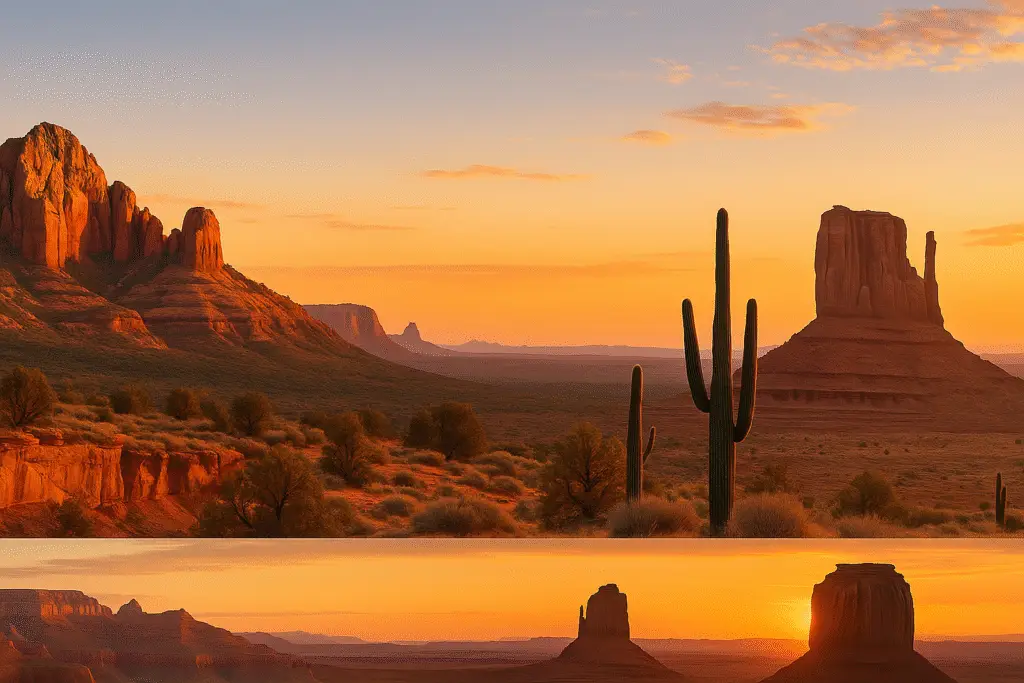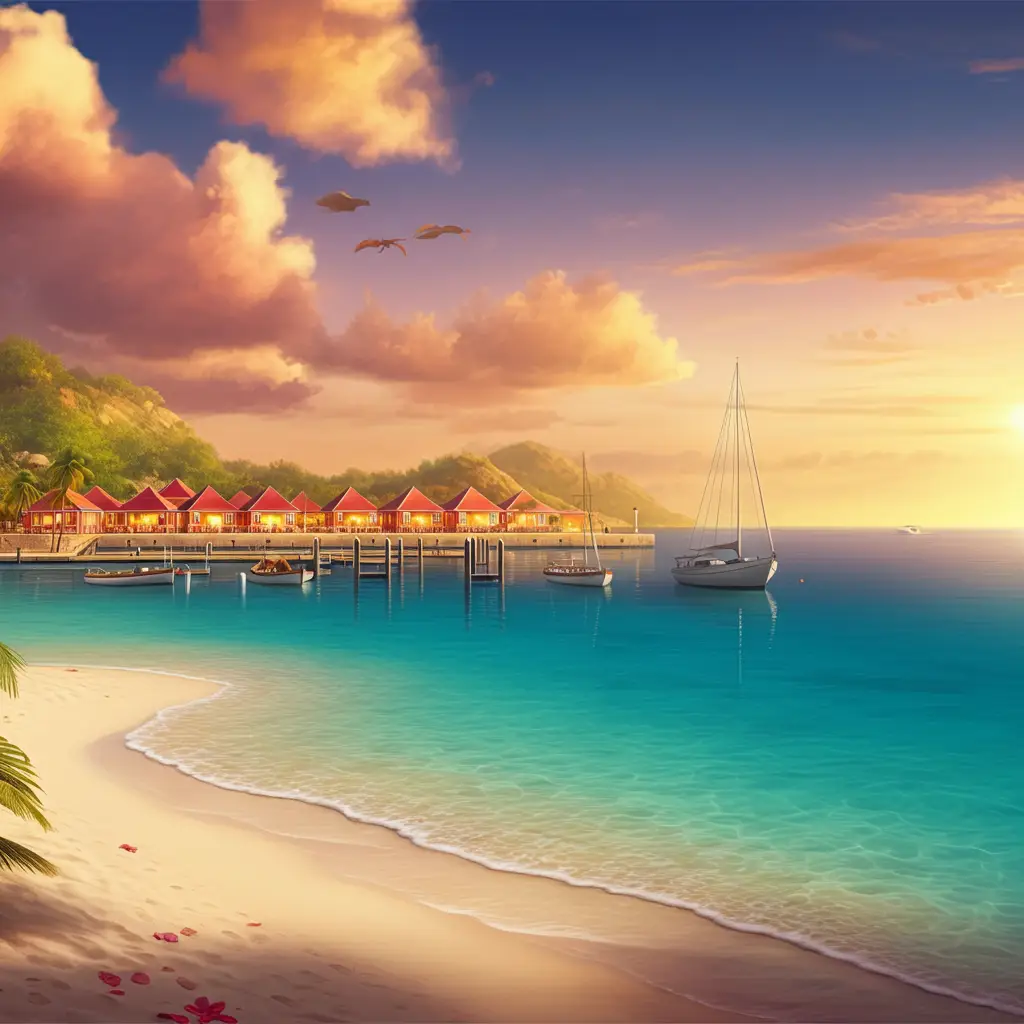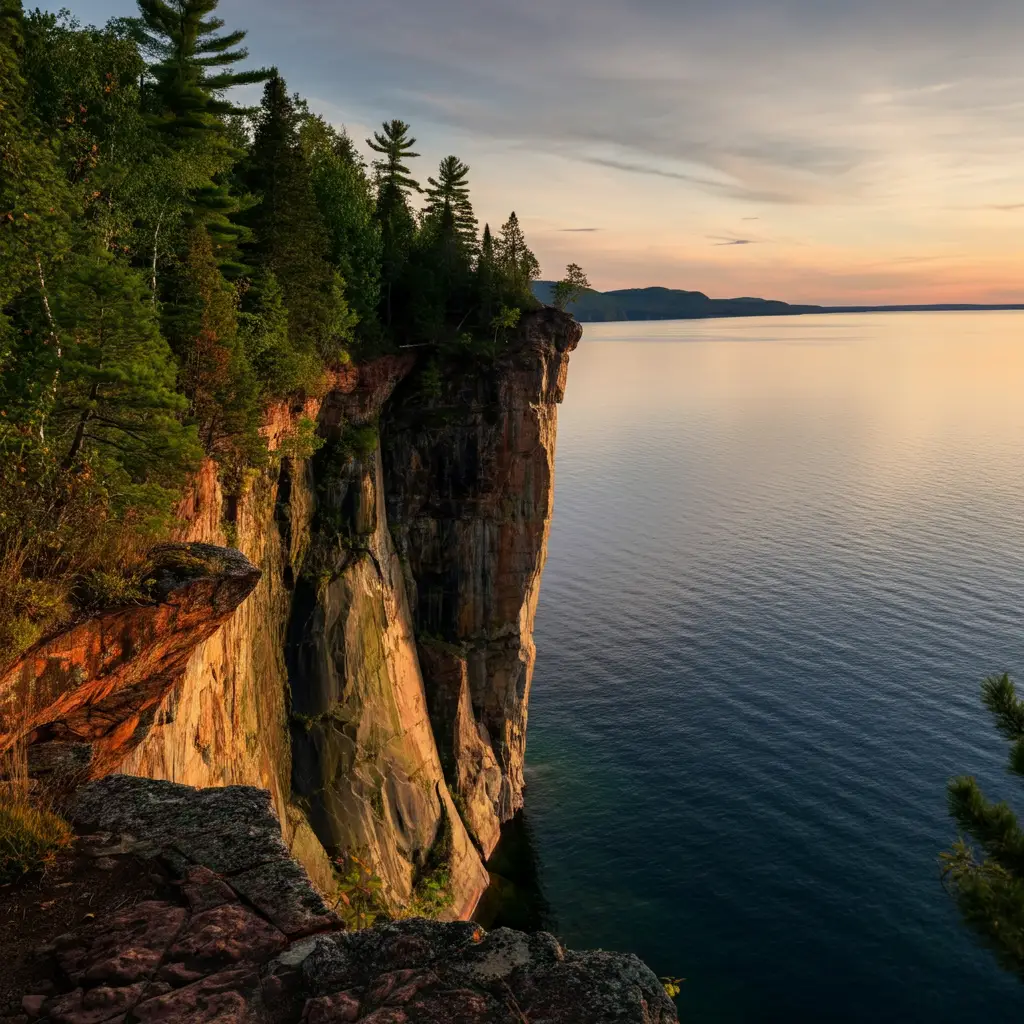Arizona: Red Rock Drama, Saguaro Forests, and Sky-Island Horizons
Arizona delivers big-canvas scenery and day-to-day variety in the same trip. One morning you stand at the Grand Canyon rim watching the light climb a mile of stone. That afternoon you trace a red-rock trail in Sedona, then finish under a Sonoran Desert sunset where saguaro silhouettes look like living sculptures. Add Indigenous homelands and heritage, architectural masterpieces, slot canyons lit like stained glass, and winter-green mountain “sky islands” above desert floor. The result: a state built for travelers who want contrast, color, and choices.
What Makes Arizona Unique
Geology you can feel, not just see. Arizona’s landscapes are a time machine carved by water, wind, and uplift. Grand Canyon National Park alone spans 278 river miles and a vertical mile of rock history, and it sits on the ancestral homelands of 11 present-day Tribal communities. National Park Service
A living desert. The Sonoran Desert carries more biodiversity than most imagine. Saguaro National Park bookends Tucson with forests of giant cacti, seasonal wildflower blooms, and trails that climb from cactus to oak and pine. National Park Service
Indigenous parks and guided access. Some of Arizona’s signature sights are stewarded by Tribal Nations. Antelope Canyon and Monument Valley are Navajo Tribal Parks where permitted, Navajo-led tours unlock the experience and context. navajonationparks.org+2navajonationparks.org+2
Four seasons in one state. High-country winters bring snow and skiing around Flagstaff, while desert winters are prime for sun and hiking. Spring brings cactus blooms; summer monsoon paints dramatic sunsets; fall turns the aspen on the San Francisco Peaks to gold. The official Arizona tourism site highlights how fast experiences shift by region. Visit Arizona+1
Must-See Highlights
Grand Canyon National Park
Nothing prepares you for the scale. The South Rim offers year-round access, wide viewpoints, and miles of rim trail. Sunrise at Mather or Yavapai puts shadow and color in motion; sunset pulls purples from far walls. The North Rim is higher, cooler, and quieter in season. Check current operations and conditions before you go. National Park Service+1
Sedona and the Red Rock Country
Buttes and fins glow at golden hour. Choose one classic: Bell Rock for approachable views, Cathedral Rock for iconic frames, or the West Fork of Oak Creek for shade, water, and canyon walls. After hiking, galleries and patios keep the day going under a red horizon.
Antelope Canyon, Horseshoe Bend, and Lake Powell
Upper and Lower Antelope Canyon are narrow Navajo sandstone corridors where beams rake the air like spotlights. Entry is by Navajo-authorized guided tour only, and a per-person Navajo Nation fee applies. Pair a tour with Horseshoe Bend’s sweeping river curve and a Lake Powell boat day. navajonationparks.org+1
Monument Valley Navajo Tribal Park
Buttes rise from high desert like a skyline built by time. Drive the 17-mile loop or book a Navajo guide to reach restricted backcountry and hear the stories that make the landscape speak. Note the Tribal entry fee and that U.S. park passes do not apply. monumentvalleytribalpark.com+1
Phoenix–Scottsdale: Desert Metropolis
Base for dining, design hotels, and sunrise hikes. Camelback, Piestewa Peak, and Papago Park give quick elevation and views. Museums run from the Desert Botanical Garden to Western Spirit: Scottsdale’s Museum of the West. Spring training turns March into a baseball festival.
Tucson and Saguaro National Park
Tucson is all light and line—mission facades, university shade, neon diners, and mountains in every direction. Saguaro National Park’s two districts frame the city. Start at a visitor center, learn desert safety, then hike a loop through giant cacti with sunset backlighting. National Park Service+1
Petrified Forest & Painted Desert
Otherworldly palettes and fossilized logs lie under big skies. Short walks deliver fast reward, and a Route 66 exhibit nods to the Mother Road that crossed here.
Hidden Gems and Low-Crowd Detours
Chiricahua National Monument
A wonderland of rhyolite hoodoos in the state’s southeast. Trails weave through “stone soldiers,” and cooler high elevations reward summer hikers.
White Pocket & Vermilion Cliffs (remote, 4×4 only)
Swirled sandstone, brain-like textures, and solitude if you put in the work. For most, a guided tour is the smart way to manage sand roads and navigation.
Canyon de Chelly National Monument
Sandstone walls cradle fields and homes still farmed by Navajo families. Scenic overlooks are easy to access by car; Navajo-led tours into the canyon floor add depth and history you can’t get from the rim.
Mount Lemmon and the Sky Island Scenic Byway
Drive from saguaros to pine forest in under an hour above Tucson. At the top: cool air, trails, and a small village for a coffee before the winding return.
Kartchner Caverns State Park
Live caves with surreal formations protected by careful access. Book early for tours; the preservation ethos makes it a standout.
Tonto Natural Bridge State Park
A travertine arch spans a pine canyon near Payson. Short trails and a shaded creek are ideal in warmer months.
Kofa National Wildlife Refuge
Desert mountains, palms in hidden canyons, and long, quiet dirt roads for serious solitude south of Quartzsite.
When to Go and How to Shape the Trip
Winter (Dec–Feb):
South and central deserts shine with mild days. Hike Saguaro, McDowell Sonoran Preserve, or Organ Pipe without heat stress. High country around Flagstaff and the North Rim is cold and can be snowy; some roads or services close seasonally.
Spring (Mar–May):
Wildflowers and cactus blooms crest with cooler mornings. It’s prime time for Sedona trails and Sonoran Desert hikes. Book early for Antelope Canyon tours as demand spikes. navajonationparks.org
Summer (Jun–Aug):
Deserts run hot. Go early, hydrate, and pivot to high-country: Flagstaff, Mogollon Rim, White Mountains, North Rim. Summer monsoon brings afternoon storms and electric sunsets; slot canyons and narrow washes can flash flood—obey closures and your guide’s direction. Navajo Tours
Fall (Sep–Nov):
Peak versatility. Aspen glow around Flagstaff; temperatures ease in Phoenix and Tucson; lake days still work in September; crowds thin at major parks after Labor Day.
Three Efficient Itineraries
1) Icons + Tribal Lands (5–7 days)
Phoenix/Scottsdale → Sedona (2 nights for trails and views) → Page (Antelope Canyon tour, Horseshoe Bend, Lake Powell) → Monument Valley with Navajo-guided backcountry → Flagstaff gateway night → Grand Canyon South Rim finale. Confirm park conditions and any temporary restrictions before finalizing timing. National Park Service+1
2) Desert Cities + Saguaro + Sky Island (4–5 days)
Phoenix/Scottsdale for food and a sunrise hike → Tucson (Saguaro NP east or west district hikes, Mission San Xavier del Bac, Barrio Viejo) → Mount Lemmon day trip for cool air and conifer scent. Saguaro spans the metro’s east and west sides, so plan drives with daylight margins. National Park Service
3) Quiet West + Caverns + Canyons (5 days)
Phoenix → Kartchner Caverns tour → Chiricahua hoodoos → Kofa Refuge for star-rich nights → back via Wickenburg’s Western museums and coffee stops.
Practical Notes for Visitors
- Hydration and heat: Treat water as gear. Start hikes at sunrise in hot months, snack on electrolytes, and build shade breaks into the plan.
- Guided access matters: For Antelope Canyon and parts of Monument Valley, licensed Navajo guides are the way in and the way to understand what you’re seeing. Check current operators and fees on Navajo Nation Parks & Recreation sites. navajonationparks.org+2navajonationparks.org+2
- Drive times and distances: Arizona is big, but highways are efficient. Anchor long days with short scenic stops—historic downtowns, bridges, and trading posts refresh the road.
- Respect closures and conditions: Desert storms, wildfire, and infrastructure work can change access. Always verify park updates on NPS or Tribal sites before you go. National Park Service+1
- Light is everything: Plan a sunrise or sunset for each region. Red rocks and canyon walls turn cinematic in low-angle light.
- Leave no trace: Cryptobiotic soil and fragile desert crust take years to recover. Stay on trail and keep distance from wildlife and cultural sites.
Why Arizona Works for Every Traveler
Families get layered days that feel different without long transfers: kid-friendly rim walks in the morning, a shaded creek trail at noon, stars at night. Couples can pair design hotels and spas with golden-hour hikes. Solo travelers find endless photography, timeless quiet, and guided cultural experiences that add meaning to the views. Arizona is variety executed at scale: desert to forest, museum to mesa, lodge to stargazing overlook, all in one arc.





